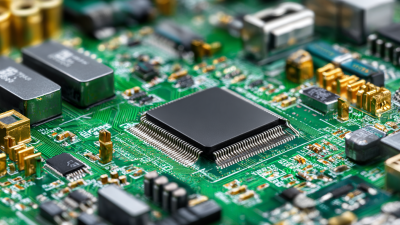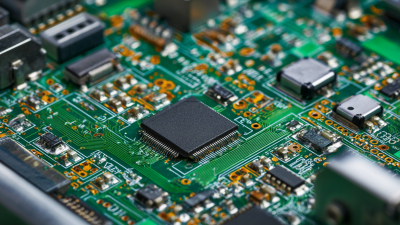Blog
Future Trends of Flex Circuit Board at 2025 China Import and Export Fair Insights and Data
The rapidly evolving field of electronics is witnessing transformative changes, particularly in the realm of flex circuit boards. As we look ahead to the 2025 China Import and Export Fair, industry insights reveal that the global flexible printed circuit board market is projected to reach approximately $40 billion by 2025, with an annual growth rate exceeding 10%. This surge is primarily driven by the increasing demand for miniaturized electronics and advancements in mobile devices, wearables, and automotive applications.

Additionally, as manufacturers continue to prioritize lightweight and compact designs, the innovation surrounding flex circuit boards is expected to play a critical role in shaping future technologies. The convergence of these trends will spotlight flex circuit boards as a crucial component at the upcoming fair, highlighting their significance in both product development and international trade.
Future Market Demand for Flex Circuit Boards in Emerging Industries
The future market demand for flex circuit boards is expected to witness significant growth, especially in emerging industries such as consumer electronics, automotive technology, and healthcare. As devices continue to become more compact and multifunctional, the need for lightweight, flexible, and efficient circuit solutions is paramount. Flex circuit boards, with their ability to bend and fit into various shapes, offer design freedom that traditional rigid boards cannot provide. This adaptability allows manufacturers to create innovative products that enhance user experience and functionality.
Emerging industries are increasingly leveraging advanced technologies like 5G, IoT, and wearables, all of which rely heavily on high-performance flex circuit boards. The automotive industry, for instance, is integrating flex circuits into electric vehicles and autonomous driving systems, where space-saving and reliability are critical. Similarly, in healthcare, flexible circuits enhance the design of medical devices, enabling better integration into wearable technologies for patient monitoring and diagnostics. As these sectors evolve, the demand for flex circuit boards will only intensify, promising lucrative opportunities for manufacturers and suppliers alike.
Technological Innovations Influencing Flex Circuit Board Production
The flex circuit board (FCB) market is witnessing significant technological innovations that promise to reshape production methodologies by 2025. As a leading component in electronics, FCBs are rapidly evolving, driven by advancements in materials and manufacturing techniques. Recent reports from industry analysts predict a compound annual growth rate (CAGR) of around 12% for the flex circuit board market, highlighting an increasing demand for lightweight and space-efficient solutions in consumer electronics and automotive applications.
One major trend influencing flex circuit board production is the shift towards automated manufacturing processes. Automation not only enhances precision but also reduces lead times and costs. Moreover, the adoption of environmentally-friendly materials is gaining traction, reflecting a growing commitment to sustainability within the industry. According to a recent market study, nearly 45% of manufacturers are expected to incorporate eco-friendly materials in their production by 2025, aligning with global environmental standards.
Tips: When selecting a flex circuit board for your project, consider the specific application requirements, such as temperature resistance and flexibility. Additionally, stay informed about the latest innovations in material science that may influence performance and durability. Regularly reviewing industry reports can also provide valuable insights that enhance decision-making and align with future trends.

Sustainability Practices in Flex Circuit Board Manufacturing
As the demand for flex circuit boards continues to rise, sustainability practices in their manufacturing have become paramount. The 2025 China Import and Export Fair highlights the increasing emphasis on eco-friendly production methods that not only enhance the life cycle of products but also reduce environmental impact. According to a recent report from MarketsandMarkets, the global flexible printed circuit board market is projected to grow from $15.2 billion in 2020 to $24.0 billion by 2025, underscoring the need for sustainable practices in an industry experiencing rapid growth.
Manufacturers are adopting several sustainable practices including the use of green materials, waste reduction strategies, and energy-efficient processes. For instance, the introduction of bio-based materials in flex circuit production can significantly decrease the reliance on petroleum-based products, contributing to a lower carbon footprint. A study by IPC International states that implementing sustainable practices can lead to a 20% reduction in manufacturing waste, ultimately benefiting companies economically while also addressing environmental concerns. With such data driving the entire industry, it's evident that sustainability will no longer be a mere trend but a critical aspect of flex circuit board manufacturing by 2025.
Trade Opportunities and Challenges at the 2025 China Import and Export Fair
The 2025 China Import and Export Fair presents a unique landscape of trade opportunities and challenges, particularly for the flex circuit board industry. With the global market for flexible printed circuits projected to reach $30 billion by 2025, driven by widespread applications in electronics and automotive sectors, businesses must navigate this dynamic environment carefully. The fair will serve as a critical meeting point for suppliers and buyers, fostering connections that can lead to lucrative partnerships.
However, companies must also be prepared for the challenges ahead. As trade policies evolve and global supply chains are tested, fluctuations in material costs and trade tariffs may impact profitability. The 2022 report from the International Trade Centre highlighted a 15% increase in tariffs on specific electronic components, underscoring the need for companies to adopt agile strategies to mitigate risks.
Tips: To thrive in this competitive landscape, businesses should focus on diversifying their supply chains, exploring local partnerships to minimize shipping times, and staying informed about regulatory changes that could impact their operations. Additionally, investing in market research can help identify emerging trends and customer demands, providing a strategic edge at the fair.

Strategic Partnerships Shaping the Future of Flex Circuit Board Supply Chains
The evolving landscape of flex circuit boards is significantly influenced by strategic partnerships that are shaping supply chains. As the demand for flexible electronics grows, stakeholders are recognizing the importance of collaboration across various sectors, including manufacturing, design, and distribution. Companies are increasingly forming alliances to enhance their capabilities in innovation, ensuring they can meet the dynamic needs of industries ranging from consumer electronics to medical devices. These partnerships facilitate the sharing of resources and expertise, leading to improved product designs and faster time-to-market.
Furthermore, these strategic alliances allow firms to leverage technology advancements and optimize their supply chains. By working closely with suppliers and logistics providers, companies can streamline operations, reduce costs, and enhance product reliability. The data from the 2025 China Import and Export Fair highlights how these collaborations not only strengthen market positions but also contribute to sustainability initiatives within the industry. As the flex circuit board market continues to expand, the focus on strategic partnerships will be pivotal in driving innovation and ensuring resilience in supply chains.
Related Posts
-

Envisioning Tomorrow: The Rise of Best Rigid Flex PCB in Modern Electronics
-

How to Choose the Best PCB Make for Your Project Success
-

Solutions for Sourcing the Best PCB Circuit Boards Globally: Your Comprehensive Guide
-

Ultimate Guide to Choosing the Right Electronic Board: Key Metrics and Insights for Success
-

Understanding the Industry Standards Challenges for Best PCB Circuit Production
-

7 Essential Reasons Why Rigid Flex Technology Is Transforming Modern Electronics
